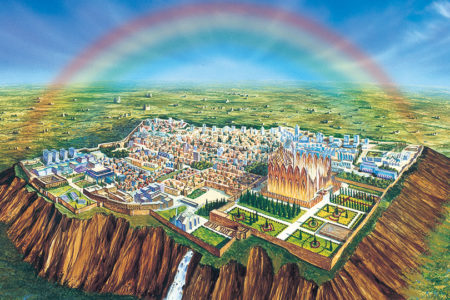The Kenosis of Jesus Christ
The Meaning of the Term Kenosis
In Philippians 2:7, the Apostle Paul stated that Jesus Christ “made himself of no reputation.” The verb translated “made of no reputation” is ekenosen. Theologians have used the major part of that verb to form the term kenosis. As a result, kenosis has become the theological term for Jesus Christ’s action described by Paul in Philippians 2:6–8.
The verb that Paul used means “to empty” (William F. Arndt and F. Wilbur Gingrich, A Greek-English Lexicon of the New Testament, p. 429). Thus, in Philippians 2:7, Paul stated that Christ emptied Himself of something. That emptying activity was the kenosis of Christ.
The Relationship of Christ’s Kenosis to His Incarnation
Paul presented two concepts that indicate a relationship between Christ’s kenosis and His incarnation. First, he stated that Christ emptied Himself “and was made in the likeness of men” (v. 7). Johannes Schneider claimed that the expression “was made in the likeness of men” was Paul’s way of saying the same thing that the Apostle John asserted concerning Christ’s incarnation in John 1:14: “the Word was made flesh” (“homoioma,” Theological Dictionary of the New Testament, vol. V, p. 197). Thus, Paul indicated that Christ emptied Himself of something in conjunction with His incarnation.
Second, Paul also associated Christ’s kenosis with His “being found in fashion as a man” (vv. 7–8). Concerning this expression, Schneider wrote, “There is special stress on the fact that throughout His life, even to the death on the cross, Jesus was in the humanity demonstrated by His earthly form…The reference is to His whole nature and manner as man” (“schema,” Theological Dictionary of the New Testament, vol. VII, p. 956). Schneider also asserted that the word translated “being found” indicates that throughout Jesus’ earthly life, His humanity “could be seen by anybody” (Ibid.). Thus, through this second expression, Paul again signified that Christ emptied Himself of something in conjunction with His becoming a human being through His incarnation.
An Important Question
In light of what Paul wrote, an important question must be asked. Of what did Christ empty Himself in conjunction with His incarnation? Several answers have been proposed, which have given birth to different views concerning the kenosis of Jesus Christ.
Incorrect Views of the Kenosis of Jesus Christ
There are at least two incorrect views of Christ’s kenosis. One view asserts that Christ emptied Himself of all of His divine attributes or deity when He became incarnated.
The other view claims that when Christ became incarnated, He emptied Himself of some of His divine attributes or deity, especially the attributes of omniscience, omnipotence, and omnipresence. Advocates of this view would argue that because Jesus Christ grew in wisdom as a child (Lk. 2:52), He must not have been omniscient (all-knowing). Because He experienced physical weariness and could be beaten, scourged, and crucified by human beings, He must not have been omnipotent (all-powerful). Because He resorted to walking or taking a boat to get from one location to another, He must not have been omnipresent (everywhere present at the same time).
There are at least two major problems with both of these views. First, both contradict Paul’s statement that in Christ “dwelleth all the fullness of the Godhead bodily” (Col. 2:9). Curtis Vaughan wrote that the Greek terms Paul used in this statement indicate that deity in its entirety took up permanent residence in the physical body of Jesus Christ at His incarnation (“Colossians,” The Expositor’s Bible Commentary, vol. 11, p. 199). Reinier Schippers stated that Paul’s terms “must mean deity, Godhead, entirety, the sum total of divine attributes” (“fullness,” New International Dictionary of New Testament Theology, vol. 1, p. 740). Thus, Paul emphasized that the physical body of the incarnated Christ housed deity in its totality. No divine attribute was missing.
Second, in the previous article it was noted that a divine nature or a human nature is a unique combination of attributes that determines the kind of a being or thing. Thus, a divine nature is a unique combination of attributes that makes a being deity instead of an angel, animal, plant, or human. Because this is so, the loss of even one of that nature’s attributes would destroy its unique combination and thereby cause it to cease being a divine nature. The loss of any attribute would change it into a different kind of nature.
In light of this, if Christ emptied Himself of even one attribute of His divine nature in His incarnation, then His divine nature ceased being a divine nature, and Christ ceased being absolute deity. Thus, both of these incorrect views of Christ’s kenosis are destructive of the deity of the incarnate Christ.
The Correct View of the Kenosis of Jesus Christ
The correct view of the kenosis is based on Paul’s contrast between “the form of God” and “the form of a servant” (lit., “of a slave,” vv. 6–7). Paul implied that Christ exchanged the form of God for the form of a slave in conjunction with His incarnation. Thus, Christ emptied Himself of the form of God.
But what is meant by the form of God? The word translated “form” refers to “outward appearance” (Arndt and Gingrich, A Greek-English Lexicon of the New Testament, p. 530). In light of this, His form of God “is the garment by which His divine nature may be known” (J. Behm, “morphe,” Theological Dictionary of the New Testament, vol. IV, p. 752). Thus, in conjunction with His incarnation, Christ emptied Himself not of His deity, but of the outward appearance of His deity.
To appreciate the significance of Christ’s emptying Himself of the outward appearance of His deity, we must note several things. First, Paul indicated that before Christ’s incarnation, He was equal with God the Father (v. 6). Gustav Stahlin stated that the word translated “equal” signifies an “equality of dignity, will and nature…which is both essential and perfect” (“isos,” Theological Dictionary of the New Testament, vol. III, p. 353). He further wrote that “Christ was and is equal to God by nature. This equality is a possession which He can neither renounce nor lose” (Ibid.).
Second, because Christ was equal with God the Father in dignity and nature, He possessed the same fullness of deity as the Father. As a result, the outward appearance of His deity was as fully visible in the spirit realm as was the Father’s outward appearance. This outward appearance was “the image of sovereign divine majesty” and was “visibly expressed in the radiance of heavenly light” (Behm, “morphe,” Theological Dictionary of the New Testament, vol. IV, p. 751). That heavenly light was the Shekinah glory of God.
Third, because Christ’s outward appearance of His deity was as fully visible as the Father’s, special privileges were made available to Him—privileges that He could have used for His own advantage and personal benefit.
Fourth, Paul stated that Christ “thought it not robbery to be equal with God” (v. 6). The word translated “thought” means “consider” (Arndt and Gingrich, A Greek-English Lexicon of the New Testament, p. 344). This, together with the meaning of the word translated “robbery,” indicates that Paul was saying the following: In His pre-incarnate existence, Christ did not consider His equality with God, with its outward appearance of deity and available special privileges, as something to be used for His own advantage and personal benefit (Werner Foerster, “harpagmos,” Theological Dictionary of the New Testament, vol. I, p. 474).
Evidence that Christ did not use His equality with God for His own advantage and personal benefit is seen in the fact that when it was time for Him to enter the world through incarnation, He emptied Himself of the outward appearance of His deity. This emptying involved two things for Him while He was in the world.
First, He veiled His divine glory (see Isa. 53:2). Christ displayed His divine glory only once while on earth in human flesh. That was in His transfiguration before Peter, James, and John (Mt. 17:1–4; Jn. 1:14).
Second, He did not use His divine attributes to benefit Himself. He did not use them to make His human life easier. He voluntarily submitted to the limitations common to humanity. Although He was omniscient, omnipresent, and omnipotent in His deity, He allowed His humanity to grow in wisdom, kept His body in one place at a time, took time to walk from place to place, and allowed humans to arrest and crucify Him. Thus, He greatly restricted the use and manifestation of His divine attributes.
The Great Exchange
When Christ became incarnated, He not only emptied Himself of His form of deity, He also took upon Himself “the form of a servant” (v. 7). The word translated “servant” refers to a slave, a person who must obey the will of another (Behm, “morphe,” Theological Dictionary of the New Testament, vol. IV, p. 750). Thus, Christ exchanged the outward appearance of His “sovereign divine majesty” for the outward appearance of an obedient, submissive slave (Ibid., p. 751; cp. 2 Cor. 8:9)
Christ took on this outward appearance of a slave by humbly submitting in obedience to God’s will in two respects: First, He died as a substitutionary sacrifice for the sins of the world in fulfillment of Isaiah 53, and, second, He died on a cross.
It was Christ’s death on a cross that especially gave Him the outward appearance of a slave. So many slaves were crucified in the Roman Empire that crucifixion was called the “slaves’ punishment” (Martin Hengel, Crucifixion, p. 51). In light of this, because Christ died on a cross, people of His day would have classified Him with slaves.
The Supreme Example
What motivated Christ to exchange the outward appearance of His sovereign divine majesty for the outward appearance of an obedient, submissive slave? The answer is love. He was more concerned for the welfare of others than for His own welfare. He gave the supreme example of self-sacrificing love for the benefit of others. Thus, in other passages Paul wrote that Christ “gave himself for our sins” (Gal. 1:4), “loved me and gave himself for me” (Gal. 2:20), and “gave himself for us” (Ti. 2:14).
Paul clearly indicated that Christians are to follow Christ’s example. He commanded us to have Christ’s mindset of self-sacrificing love for the benefit of others. In Philippians 2:3–5, he wrote, “Let nothing be done through strife or vainglory, but in lowliness of mind let each esteem others better than themselves. Look not every man on his own things, but every man also on the things of others. Let this mind be in you, which was also in Christ Jesus.” According to Georg Bertram, Paul was indicating that Christ’s mindset in conjunction with His kenosis “is itself the standard for the mind of believers whose fellowship is constituted by Christ” (“phroneo,” Theological Dictionary of the New Testament, vol. IX, p. 233). Paul again signified the same when he wrote, “And walk in love, as Christ also hath loved us, and hath given himself for us an offering and a sacrifice to God for a sweet-smelling savor” (Eph. 5:2).







I have some questions for Dr. Showers (May he RIP):
1. Why did Jesus, who is deity robed in flesh, tell us we could do greater miracles than He could? He was God! Can we ever match Him let alone surpass Him? Perhaps we need to get more familiar in this lifetime with the third person of the trinity?
2. What is so special about being of the flesh? Why wasn’t God satisfied with just angels? These are spiritual beings of far greater power than us. But as with humanity, angels had freedom of choice and need salvation too, I would think.
3. Why would God’s creation, Satan, leave a heavenly bliss to rebel and leave? Are all of God’s creation subject to similar human (and therefore, Godlike) traits to have feelings of jealousy, pride, envy, selfishness? It seems strange. Perhaps not answerable since any response would be speculative.
4. Why don’t we call on Angels to help us more so? Jesus did when he was in human form. Is it right to do so? If Jesus is omnipresent, as well as the Holy Spirit, then what are angels for? Are they in the heavenlies fighting the demon enemies? From what I have read, the demons are outnumbered 2 to 1. So… maybe the battle is over and already won. After all, Jesus can destroy all with the one breath!
5. What are angels doing right now and are we allowed to call upon them? Or are we only allowed to use them as bumper guards for “travel safety”?
6. Finally, why will humans judge angels? Why should we ever have that opportunity, let alone capability to do so? Why are we so special? If we are to judge them, how can we? We are conditioned to “judge not”.
To me it has always been fairly simple to see what Jesus himself of in His coming to earth in the incarnation. The key is in Philippians 2:8 in the first half of the verse, “And being found in appearance as a man, He humbled Himself…” Jesus was royalty, a king. He laid down His crown and emptied Himself of His glory and became “humble”. It’s sort of reminiscent of Mark Twain’s The Prince and the Pauper. The two young men looked alike and the prince wanted to find out what it was like to live as a regular person and vice versa. So the two switched places. The prince humbled himself and the pauper was exalted. That is sort of the portrait we see here of Christ.